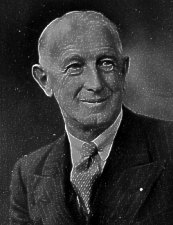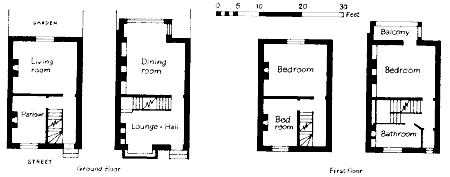
Bassett-Lowke age 70 in 1947 [Baily incorrectly attributes it to 1927]

Bassett-Lowke age 70 in 1947 [Baily incorrectly attributes it to 1927]
An interesting connection with Knockaloe was that of Wenman Joseph Bassett-Lowke (1877-1955) - usually known as Whynne Bassett-Lowke and the founder in 1909 of the famous model engineering busines Bassett-Lowke Ltd. Son of John Thomas Lowke the stepson of Abraham Bassett and his second wife Mrs Tom Lowke, Whynne adopted the name Bassett-Lowke possibly to distinguish his model engineering activities from those of his father J T Lowke who ran a small engineering business in Northampton and who gave considerable backing to his son at the the start of the business from the late 1890s and possibly to reflect the help his step-grandfather also gave him in the early days as Whynne grew a business initially making components for amateur modellers, originating from a schoolboy interest in model steam engine..
The continental model business especially the German toy industry based around Nuremburg was considerably in advance of the then British industry especially in the needed precision to allow economic mass manufacture - Whynne was introduced to these manufacturers by Percival Marshall editor of the Model Engineer magazine and developed strong links with two such companies Carette and Bing who produced models to Bassett-Lowke's specifications for the British market. Whynne was a great traveller, especially by rail, and visited the continent at any opportunity. He was also a member of the Fabian Society and Fuller in his biography states he was a pacifist and goes on to note [pp30/1]:
Several of his German friends and business contacts were in London at the outbreak of the war and they were all interned at Peel on the Isle of Man. Whynne secured a permit and regularly visited them until the time of their release. One internee's story was particularly poigrant, A German manufacturer's representative in London, named Oppenheim was interned only a few days after marrying a young English girl, Miss Wilmott, who had been secretary to the company's London manager, Hobbs. Although business was not sufficient to require her services, Whynne employed her right through the war until she could rejoin her husband at the end of 1918. They quite soon went to Germany, suffered during the years of depression in that country and then, being a jew, Oppenheim was sent to a concentration camp, where he died.
A Violett E Wilmot who married an Oppenheimer (possibly a Robert Oppenheimer) can be found in the index for the marriages in the 4th quarter of 1914. Unfortunately I can find no record of this internee, the majority of Jews held in Knockaloe were transferred to the Jewish camp in Douglas from mid 1915 onwards - there is a Ludwig Oppenheimer transferred to the Jewish camp in July 1915 and then to Spalding for repatriation 11th Dec 1918. So far I have found no application for a visit by Bassett-Lowke or for Mrs Oppenheimer who having married a German national became in law an enemy alien and subject to many petty restrictrictions.
J T Baily in his notes, held at Manx Museum, notes that Bassett-Lowke visited the Island
"to discuss the possibilities of our making some of his small waterline ship models. He supplied a finished model of each kind and proposed to send prepared materials. Following enquiries we discovered an ex-seaman PoW Wilhelm Kurth who had just the qualifications, he was skillful, careful about details, particular about a clean finish and methodical; J. B-L [Baily always refers to him as J Basset-Lowke] took to him at once and a small group was organised by Kurth to assist him. It was a work of mass and it was interesting to see him placing the models across two long boards inspecting bow and stern aline and sighting masts for accuracy of heights and angle of the slope. And he got the paint finish excellently done.
Baily then states "there were models of the Lusitania, Cap Trafalgar" - the Lusitania, sunk by U-boat in 1915 would seem to be a strange choice to be worked on by internees.
Kurth was repatriated at the end of the war, married but died in 1921 aged 44 - Bassett-Lowke had kept in contact and arranged work for him + others.
The other interesting connection with Knockaloe was the order Bassett-Lowke placed with the workshop established at Knockaloe under the guidance of J T Baily for furniture design by Charles Rennie Mackintosh and possibly by himself. This order was in advance of B-L's marriage in 1917 and was intended for his first marital home at 78 Derngate - Narissa Levy writing in a section of Fuller's biography comments on B-L's interest and support for modern architecture - B-L had contacted Mackintosh in late 1915 to transform the small 2up-2down terraced house he had bought from his parents into a suitable marital home - Mackintosh also designed many of the fittings and decoration for the house. Retaining much of the traditional street frontage the modern and in Levy's words revolutionary aspects, were out of the public gaze at the rear of the property which had a garden sloping away from the house which allowed the ground floor dining room to be extended, above which was built a balcony for the the upstairs bedroom.

Plan of 78 Derngate showing the considerable alterations (taken from Fuller) - underneath the dining room is a basement
kitchen
Some of the furniture is shown in the paper written by Baily - it is likely that B-L designed the plain walnut furniture which like the Mackintosh designed furniture was made by skilled German craftsmen at Knockaloe.
In 1927 B-L moved to a new house, New Ways, but this time to a design by German architect Paul Behrens, done by correspondence without the architect ever visiting the site
Roland Fuller The Bassett-Lowke Story London: New Cavendish Books 1984 ISBN 0 904568 34 2
|
|
||
|
|
||
| Any comments, errors or omissions gratefully received The
Editor © F.Coakley , 2019 |
||